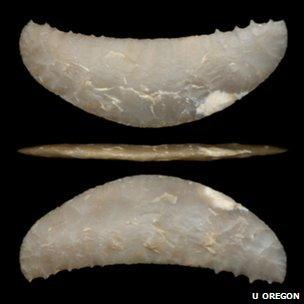Island tool finds show early settlers' diversity
- Published

The barbed points may even have been arrowheads, which would move the earliest known use of arrows back by thousands of years
Caches of tools and animal remains from around 12,000 years ago, found on islands off the California coast, have given remarkable insight into the lives of the first Americans.
The finds show fine tool technology and a rich maritime economy existed there.
The tools vary markedly from mainland cultures of the era such as the Clovis.
The finds, reported in Science, external, also suggest that rather than a land route to South America, early humans may have used coastal routes.
A team studying California's Channel Islands, off its southern coast, has found that the islands show evidence both of differing technologies and a differing diet, even among the few islands.
"On San Miguel island we found a lot of pretty remarkable tools, but the animal materials there were largely shellfish," said Torben Rick, an anthropologist from the Smithsonian Institution in Washington DC.
"Over on Santa Rosa, that site was dominated by bird remains and a few sea mammal and fish remains... and no shellfish at all.
"What's interesting about that is it shows us not only were these people out there living a coastal life, but they were taking advantage of the full suite of resources available to them; they had a very diversified maritime economy."
The tools that the team found hold the greatest surprise, however, in that they differ significantly from those of mainland cultures like the Clovis and Folsom.
Points found on the islands - which could even be arrow-heads - are thin, serrated, and have barbed points that show striking workmanship for the period.
Inland tools had fluted points, and it is known they were used to hunt large animals including the woolly mammoth. The island points were so delicate as to almost certainly have been used for hunting fish. What is more, many of them do not reappear in the archaeological record.
"These are extremely delicate, finely made tools that don't occur later in time," Dr Rick said. "Finding these types of tools at all three of these sites really suggests a similar group of people, in terms of technology and subsistence - and were pretty different from what came later."
Dr Rick said that the evidence supported the idea that the islands were short-term or seasonal encampments, rather than permanent settlements. The team also found a piece of obsidian on the islands.
"The Coso obsidian source [is] on the mainland a couple hundred miles away, so we know they were participating in long-distance exchange networks," he said.
'More surprises'
A long-standing model of human exploration and settlement of the Americas holds that, after reaching North America through the Bering Straits off Alaska, a concerted push southward led early humans including the Clovis culture across inland parts of the continent to South America.
But anthropologist Tom Dillehay of Vanderbilt University said that the Channel Island finds were part of a mounting body of evidence against that simplistic story.

The thin, serrated crescents are a testament to the island inhabitants' manufacturing capabilities
"What they tell us is that there was widespread cultural diversity at the outset of human entry and dispersion throughout the Americas, and that the old, now-dead Clovis first model often misleads us to believe that there was only one major way of first human expansion throughout the Western Hemisphere," he told BBC News.
"As today, there are cultural continuities but there also is constant change, which is well evidenced by these and other sites being discovered throughout the Americas. As more research produces more sites, we will see that the story of the first Americans is not linear and that there will continue to be more surprises.
"As I have published and said before, there were probably many different migrations and many different migration routes overland and along the coastal ways, and this evidence is pointing in that direction too."
However, Dr Rick said that it was too early to upend the larger picture of human migration across the Americas, and that further finds - some of which now lie underwater around the Channel Islands - could shed more light on the story in the future.
"My colleague Jon Erlandson refers to them as 'postcards from the past'," Dr Rick said. "They give us just a brief snapshot of 'hey, we were here and here's what we were doing for a brief period of time'.
"We have to be a little cautious in our interpretations; we're trying to put together a puzzle, and the puzzle may have 150 pieces and we've got five of them. So it's really difficult to get the full picture of what they were doing."
- Published26 October 2010
- Published2 December 2010